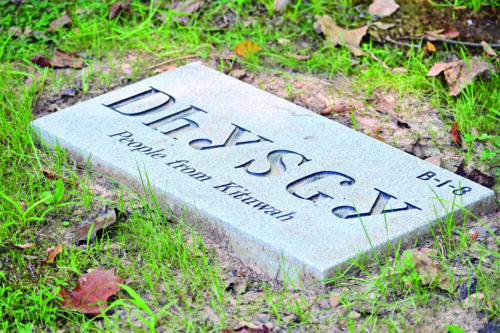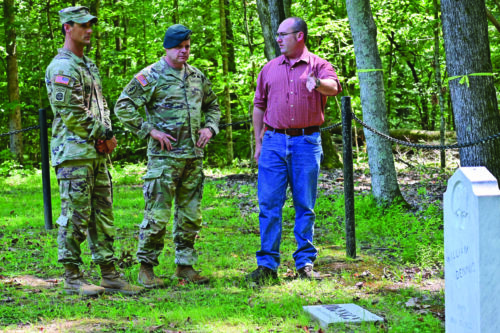By SCOTT MCKIE B.P.
One Feather Asst. Editor
FORT CAMPBELL, Ky. – Over 50 Native American ancestors were reburied at an Army base and a national recreation area two years ago, and now a headstone inscribed with the Cherokee syllabary marks one of the sites. In a collaboration between the Eastern Band of Cherokee Indians (EBCI) and Fort Campbell, the remains were reburied, and a headstone placed recently marks that site on the Army base.
“The total number of ancestors reburied at Fort Campbell and Land Between the Lakes National Recreation Area was 57 with 516 associated funerary objects,” said Miranda Panther, NAGPRA (Native American Graves Protection and Repatriation Act) officer with the EBCI Tribal Historic Preservation Office. “According to the background information of the project, the human remains and funerary objects were previously housed at multiple repositories throughout the U.S., but were later consolidated at the Pratt Museum to facilitate compliance.”

A special marker has recently been placed on the gravesite of over 50 Native American ancestors who were reburied in 2021 at the German POW Cemetery at Fort Campbell, Ky. The headstone is inscribed with the word ‘Anigiduwagi’ in the Cherokee syllabary. (U.S. Army photo by Kayla Cosby)
Ron Grayson, cultural resources program manager with Fort Campbell Directorate of Public Works, said in a press release, “We had to try and identify the remains that we had in our collection or whoever the closest living descendants were. This process can sometimes be easy if the remains are more modern and have similar clothes or artifacts as neighboring tribes.”
According to a release from the Fort Campbell Public Affairs Office, “All the remains, as well as AFOs (associated funerary objects), were stored at the University of Kentucky until 2017, when they were transferred to the Cultural Resource Office at Fort Campbell. Four of these remains were repatriated at the Land Between the Lakes National Recreation Area with coordination through the United States Forest Service.”
That release also states, “A cemetery created by the Army in the 1940s that housed German Prisoners of War (POW) who died in WWII was selected for the reburial site. It is one of 22 post cemeteries administered by the OAC (Office of Army Cemeteries). After the EBCI THPO approval of the location, the remains were reinterred in the German POW Cemetery July 21, 2021.”
Panther noted it was truly a joint effort, “There were 12 federally recognized tribes who were a part of the consultation process. All of the consulting tribes have an interest in the state of Kentucky or are aboriginal to the state. The EBCI took the lead, but it was a joint effort with the other two Cherokee tribes.”
On the process, she related, “Consultation on this project started pre-COVID, but it took almost six years to get to the installation of the headstone. This was one of the first reburials we completed once the pandemic was easing up. We also worked with the U.S. Forest Service as they graciously provided reburial assistance for some of the ancestors.”
The headstone is inscribed with the word ‘Anigiduwagi’ in the Cherokee syllabary. Panther said, “This means ‘any person from Kituwah’, but due to translating it to English in a plural form, ‘People from Kituwah’ was used on the headstone.”
Panther added, “The NAGPRA process with Fort Campbell went smoothly. This process can inherently be lengthy, but Ron made every effort to be transparent and to keep our office updated. Locating a secure and protected reburial spot as close as possible to the original burial is often the most difficult part of a NAGPRA project. The Eastern Band of Cherokee Indians Tribal Historic Preservation Office (EBCI THPO) was appreciative that we would be able to rebury the ancestors and their belongings back on the Fort Campbell property. Despite the extra paperwork this required, it is meaningful to have a headstone with Cherokee syllabary present in the cemetery. We are also thankful to the USFS and Land Between the Lakes National Recreation Area for allowing us to rebury part of the Fort Campbell collection on their property.”

Fort Campbell Garrison Commander Col. Andrew Q. Jordan and Garrison Command Sgt. Maj. Chad Stackpole receive a briefing about Fort Campbell’s German POW cemetery from Ron Grayson, the Cultural Resources Management Program manager, July 28. As part of his final tour as the garrison commander, Jordan, a citizen of the Cherokee Nation, visited the cemetery. (U.S. Army photo by Kayla Cosby)
In speaking of the magnitude of the NAGPRA law for the EBCI, Panther said, “It is of utmost importance to have a comprehensive and dedicated team devoted to NAGPRA work as it is a mission that all of us at the THPO are united behind. We all recognize how meaningful it is to advocate on behalf of Cherokee ancestors whose graves have been disturbed without permission or consent. Beau Carroll and Johi Griffin are bearing the physical and spiritual burden of every reburial we conduct. I’m beyond grateful to have their guidance and support, as well as my other coworkers at the THPO who have assisted in archaeological, historical, and ethnographical research needed for some of the NAGPRA projects we’re involved in.
Col. Andrew Jordan, a Cherokee Nation citizen and former Fort Campbell Garrison Commander, said in a press release, “The historic marker placed on the remains at the German POW cemetery is a significant effort to honor and remember our ancestors. Fort Campbell’s commitment to being good stewards of the land and culture is commendable. Understanding the history of how this land was provided to the United States government to create Fort Campbell reminds us to appreciate and preserve what we have inherited.”
Panther summed up the importance of work such as this, “I do believe in a spiritual sense, that we are righting a wrong that was committed against these ancestors when their graves were disturbed or excavated. They have also been languishing on shelves for decades despite NAGPRA being in place for over 30 years. Our goal is to respectfully rebury as many ancestors and their belongings as possible so that they can be put back to rest.”



